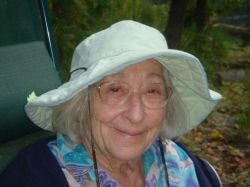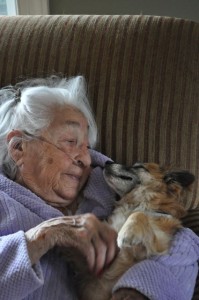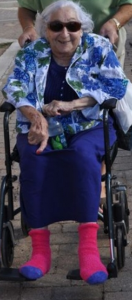 Making the final decision of hospice for your elderly loved one
Making the final decision of hospice for your elderly loved one
Note to readers: this article was first posted on Squidoo in 2011. I’ve left it as I originally wrote it although my darling Mom, Gertie, passed away Feb 15, 2012.
After a recent week in the hospital to clear pneumonia, during which I was relegated to sleeping on a pull out sofa, my wonderful Mom, my brothers and I made the choice of enrolling her in hospice for the best end-of-life care.
For us, it was actually a relatively easy choice as my mom lives in my home and is cared for by me and my wonderful caregiver, Carina. We all wanted her to remain in my home. Not only will Mom be surrounded by those people she loves, but she’ll be in a familiar environment and, we believe, she can be kept more comfortable with hospice care. And I, as the primary caregiver, will also get more support through hospice services as will be shown in details below.
But, before we made the decision, I had to explore what exactly hospice services offer and then had to explain the program to my mom, in minute detail. I’m hoping the information in this article will educate you and help you and your loved ones make the right decision for your elderly parents, aunts, uncles, or, even yourself, when the time comes.
Hospice Services = Comfort Care
The primary idea of hospice services is to provide comfort care to your elderly loved one. This means that your love one will be as comfortable and pain-free as possible during the last phase of their life.
When I started to care for my mom after my dad died (4.5 years ago), I was fully unprepared for what I was getting into. I have found though that I’ve developed into an intuitive caregiver. I adopted the mantra early on to “treat the symptoms and let the disease run its course.” There have been times when I’ve butted heads against various doctors who wanted to perform procedures which would have been invasive and, imho, unnecessary for a 94 year old. I’ve sought out physicians and a wonderful dentist who share my philosophy and, so far, so good.
My innate philosophy and hospices’ matched perfectly. Comfort care is what I was providing without even realizing it. I guess I was preparing myself and my Mom all along for comfort care when the time came. And, that’s where we are today.
I want my mom to be as comfortable, safe and happy as she can be during these last days./weeks/months/years of her life. Hospice is the clear answer for my mom, myself, and my family.
What are the requirements for hospice care?
- Estimated life expectancy of less than 6 months. Two doctors had to verify that my Mom’s life expectancy is less than 6 months – her primary care physician and the head doctor of hospice. I contacted hospice services when Mom was in the hospital last week for pneumonia and appeared to be failing fairly quickly. The ER doctor gave us a 40% chance of survival but he didn’t know my Mom. We did prepare for the worst but I had a feeling that the fighter in Mom wasn’t done – and she wasn’t. We did take the offer of hospice services though and had to accept that her life expectancy is less than 6 months.Now, don’t panic – just because hospice is offered to your family’s love one doesn’t mean they have an expiration date! By the very fact that my mom is 94, her life expectancy is less than 6 months but, with the right hospice and home care, I expect her to exceed that expectation. If she does exceed the 6 months, the doctors will just re-admit her for another 6 months, indefinitely.
- A patient who has a terminal illness where cure is unlikely is a candidate for hospice services. If the patient improves, it may be found that hospice support is no longer needed. In this case, hospice care will be discontinued. In the future, if the patient again fails and again diagnosed with a terminal illness with no cure, re-enrollment into hospice will be offered.
- A patient who needs 24 hour monitoring or care is also eligible for hospice services. Along with a life expectancy of less than 6 months, this is the category where my Mom fits in – she requires my or a caregiver’s care for moving around the house, to prepare her meals, to provide entertainment and conversation, or for general daily living tasks.
Understanding the personnel associated with hospice….
…and their roles in patient comfort care
When your loved one is enrolled in hospice, there are many personnel who will support his or her comfort care and even offer supportive services to the caregiver. The below are the main personnel associated with most hospices.
- A visiting nurse. The crux of your hospice team is the visiting nurse. Since comfort care is the core philosophy behind hospice, most patientswill be seen by a nurse wherever the patient resides – your home, a nursing facility, an assisted living facility or an inpatient hospice facility. The goal is to treat the symptoms and keep the patient comfort in the last months of life.Our hospice offers once a week nursing visits with the same nurse during which time my Mom’s conditionwill be assessed, vital signswill be monitored, and her general condition noted. Nursing visitsmay be needed more than once a week and hospice will respond in kind. I find this type of supportto be an incredible freeing feeling as it’s no longer just me making health decisions.Since Carina and I are with my mom on a daily basis, I feel that it’s nice to have a third pair of trained eyes looking for signs and symptoms of illness that we might miss. This alone, for me, is a great reason to have hospice services.
- A physician. Each hospice patient is assigned to a physician. If your loved one’s primary care physician is associated with the hospice program, the change from primary care to hospice care will be seamless. The overseeing physician is available to the nurse who will fill them in on the patient’s condition where they will direct future care to the wishes of the patient and family.
- A social worker. The social worker assigned to your senior citizen’s case is an advocate for the family and caregiver. The social worker will visit the patient and the family periodically and may offer solutions to problems of which the family was unaware. Frequently, the social worker knows of community programs which may benefit the caregiver or family of hospice patients.
- Volunteers. The hospice program was, once upon a time, started as a volunteer organization and, even today, volunteers play a large role in hospice care. With advanced scheduling, trained hospice volunteers will come to wherever the patient resides toassist the caregiver by running errands, visiting the patients, or staying with the hospice patient so that the caregiver or family member can get out to run errands as needed.As the primary caregiver for Mom, I sometimes am alone with her while our paid caregiver, Carina, is off. This means that I’m pretty much either tied to the house or, if it’s a good day for Mom, I take her with me on errands. But, even on good days, I can’t always completeall of the tasks I need to get done as Mom tires pretty easily.I particularly like this visitor offered by Hospice as there are times when I have no one to stay with Mom while I go out for a bit for vet visits (frequently!) or run to the pharmacy. It’s nice to know that, for example, every Wednesday from 9-11 am, I can be freed up to get out for a bit whether Carina is here or not. Note: volunteers general are not allowed to serve meals or dose medications. Check with the particular Hospice organization for the rules.
- Nursing aides. Nursing aides are available to the hospice patient to do things such as assist with bathing, eating, to make sure the patient is comfortable and can move around as needed. Nursing aides can be called in as needed to assist the elderly and the caregiver with many daily living tasks.
- A chaplain. Hospice chaplains are denominational and offer support to all hospice patients alike. If your loved one is not very religious at all, consider the chaplain just another friendly support person who will drop by periodically to check on you and your loved one.
 Additional services provided by hospice service staff
Additional services provided by hospice service staff
I’ve detailed the hospice personnel staff and their roles above, but there are additional items which hospice provides which may help the patient, caregiver and family.
- 24 hour nurses on call. When one is enrolled in hospice, it’s best to call hospice nurses at any time of the day or night for emergencies instead of 911. There’s always a hospice nurse on call, and he or she usually calls back in minutes after a call is sent to them. Physical response time may vary depending on where the nurse is in the county but is generally within 30 minutes or so. You can also call a nurse at any time with questions about medication, diet, etc. This support is critical in continuing to have my Mom remain in my home.
- Inpatient care and respite care. Although the ultimate goal is to keep your elderly loved one in your home, hospice services may recommend inpatient care for an ill hospice patient. All hospices have some sort of inpatient facility where an ill loved one may be treated instead of a hospital. The inpatient care facility is generally set up like a family home instead of a hospital – there are fewer rooms, rooms are set up like bedrooms to be cozy, there are extra beds for family members to rest in, there’s usually kitchen facilities, a livingroom, etc. The inpatient care facilities are staffed with hospice nurses, aides, and doctors so treatment mimics hospital care except it’s a much warmer environment.Upon occasion, hospice services may also recommend respite care to allow family members a break. During respite care, a hospice patient may be admitted to the inpatient facility or a short term group home.
- Assistance with setting up the home environment so it’s comfortable and conducive to having the elderly loved one stay there. Hospice arranged for a hospital bed, oxygen tanks and, if needed, would have arranged for many more items I need to have my mom at home (most of the stuff I already had). Help with questions is only a phone call away.
- When the time comes, hospice personnel arrange for transportation to the funeral home of your choice. Someone is also available to stay with the family members after the death of a loved one, if needed.
- Bereavement support. Once the ultimate moment of death arrive, hospice staff step in to help from everything from arranging for the funeral home to providing counseling services to the family. Bereavement support may include counseling sessions, telephone calls, emails of support for the surviving family members. Hospice services may also bereavement support groups for all ages.
Who foots the bill for hospice services?
Hospice is generally paid through Medicare, Medicaid or private insurance.
Medicare Part A may pay for additional services not related to the hospice diagnosis. For example, my Mom was entered into hospice with a diagnosis of CHF (cardiac heart failure). She has a very arthritic knee and gets treatments every 5 weeks as a series of shots. The knee treatment is not related to her heart issues so Medicare Part A will continue to pay for those treatments.
Medicare prescription plans (such as Medicaid Part D) pays for the prescriptions related to the hospice diagnosis, including pain medications.
In closing, our experience with Hospice couldn’t have been better. Instead of being a desolate, depressing time, Hospice help allowed me more mother-daughter time with my Mom; time when I was just plain old Lori and she was just plain old Mom.
Book On Hospice Care
Living at the End of Life: A Hospice Nurse Addresses the Most Common Questions One Foot In Heaven, Journey of a Hospice Nurse
One Foot In Heaven, Journey of a Hospice Nurse Hospice and Palliative Care: The Essential Guide
Hospice and Palliative Care: The Essential Guide The Hospice Handbook: A Complete Guide
The Hospice Handbook: A Complete Guide
&

Leave a Reply